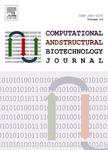版权所有:内蒙古大学图书馆 技术提供:维普资讯• 智图
内蒙古自治区呼和浩特市赛罕区大学西街235号 邮编: 010021

作者机构:Qilu Univ Technol Shandong Acad Sci Sch Bioengn Jinan 250300 Shandong Peoples R China Yunnan Normal Univ Sch Life Sci Kunming 650500 Yunnan Peoples R China Qilu Univ Technol Shandong Acad Sci Kyiv Coll Jinan 250300 Shandong Peoples R China
出 版 物:《COMPUTATIONAL AND STRUCTURAL BIOTECHNOLOGY JOURNAL》 (Comput. Struct. Biotechnol. J.)
年 卷 期:2025年第27卷
页 面:214-220页
核心收录:
基 金:National Natural Science Foundation of China Yunnan Fundamental Research Projects [202401CF070034] Shandong Provincial Natural Science Foundation [ZR2016HB54] Shandong Provincial Key Laboratory of Microbial Engineering (SME)
主 题:Circular Permutation Protein Language Models Protein Structure Alignment
摘 要:Protein circular permutations are crucial for understanding protein evolution and functionality. Traditional detection methods face challenges: sequence-based approaches struggle with detecting distant homologs, while structure-based approaches are limited by the need for structure generation and often treat proteins as rigid bodies. Protein Language Model-based alignment tools have shown advantages in utilizing sequence information to overcome the challenges of detecting distant homologs without requiring structural input. However, many current Protein Language Model-based alignment methods, which rely on sequence alignment algorithms like the Smith-Waterman algorithm, face significant difficulties when dealing with circular permutation (CP) due to their dependency on linear sequence order. This sequence order dependency makes them unsuitable for accurately detecting CP. Our approach, named plmCP, combines classical genetic principles with modern alignment techniques leveraging Protein Language Models to address these limitations. By integrating genetic knowledge, the plmCP method avoids the sequence order dependency, allowing for effective detection of circular permutations and contributing significantly to protein research and engineering by embracing structural flexibility.